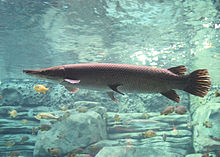
Semionotiformes is an order of ray-finned fish known from the Middle Triassic (Anisian) to the Late Cretaceous (Maastrichtian). Their closest living relatives are gars (Lepisosteidae), with both groups belonging to the clade Ginglymodi within the Holostei. The group includes both freshwater (Semionotidae) and marine adapted forms. Many members of the family Macrosemiidae, had elongated dorsal fins, often associated with an adjacent area of skin which was free of scales. These fins were likely undulated for use in precision swimming. The body morphology of macrosemiids suggests that they were slow swimmers who were capable of maneuvering around complex topography, such as reef environments.

Gars are an ancient group of ray-finned fish in the family Lepisosteidae. They comprise seven living species of fish in two genera that inhabit fresh, brackish, and occasionally marine waters of eastern North America, Central America and Cuba in the Caribbean, though extinct members of the family were more widespread. They are the only surviving members of the Ginglymodi, a clade of fish which first appeared during the Triassic period, over 240 million years ago, and are one of only two surviving groups of holosteian fish, alongside the bowfins, which have a similar distribution.
Lepisosteus is a genus of gars in the family Lepisosteidae.
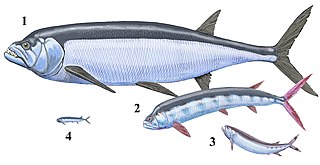
Ichthyodectiformes is an extinct order of marine stem-teleost ray-finned fish. The order is named after the genus Ichthyodectes, established by Edward Drinker Cope in 1870. Ichthyodectiforms are usually considered to be some of the closest relatives of the teleost crown group.

Axelrodichthys is an extinct genus of mawsoniid coelacanth from the Cretaceous of Africa, North and South America, and Europe. Several species are known, the remains of which were discovered in the Lower Cretaceous (Aptian-Albian) of Brazil, North Africa, and possibly Mexico, as well as in the Upper Cretaceous of Morocco (Cenomanian), Madagascar and France. The Axelrodichthys of the Lower Cretaceous frequented both brackish and coastal marine waters while the most recent species lived exclusively in fresh waters. The French specimens are the last known fresh water coelacanths. Most of the species of this genus reached 1 metre to 2 metres in length. Axelrodichthys was named in 1986 by John G. Maisey in honor of the American ichthyologist Herbert R. Axelrod.
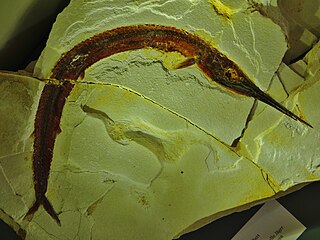
Belonostomus is a genus of prehistoric ray-finned fish that was described by Louis Agassiz in 1844. It is a member of the order Aspidorhynchiformes, a group of fish known for their distinctive elongated rostrums.

Calamopleurus is a prehistoric genus of marine halecomorph ray-finned fish from the Early Cretaceous of South America and northern Africa. It was a relative of the modern bowfin, with both belonging to the family Amiidae.
Enischorhynchus is an extinct genus of prehistoric marine ray-finned fish that lived during the Late Cretaceous. It contains a single species, E. dallasensis from the late Santonian or early Campanian-aged Austin Formation of southern Texas, USA. It was a member of the Plethodidae, a dominant family of nektonic fish during the mid-late Cretaceous. It shows close morphological similarities and may be related to Concavotectum and Bachea. It was likely an endemic of the southern Western Interior Seaway.
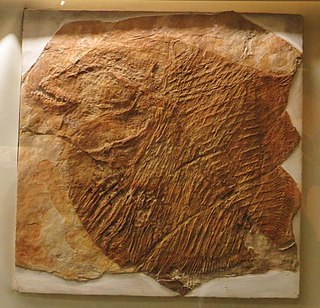
Coelodus is an extinct genus of marine and possibly freshwater pycnodont fish. It contains only one definitive species, C. saturnusHeckel, 1854, from the Late Cretaceous of Slovenia. Other species from the Late Jurassic to the Eocene have also been attributed to this genus based on isolated dental elements, but their assignment to Coelodus is uncertain, and this genus likely represents a non-monophyletic wastebasket taxon. A potential diagnostic trait is a prearticular tooth row with three regular highly elongated teeth.

The Csehbánya Formation is a geological formation in the Transdanubian Mountains of Veszprém County, Hungary. The formation dates to the Late Santonian of the Late Cretaceous. It represents a floodplain environment as opposed to the swampy lacustrine environment of the simultaneous Ajka Coal Formation, though there is complete overlap in terms of fauna. It underlies the Jákó Marl Formation, and laterally transitions to the Ajka Coal Formation.

Spathiopterygidae is an extinct family of small parasitic wasps, known from the Cretaceous of Laurasia and Northern Gondwana. They are suggested to be members of Diaprioidea, in part due to their similarly reduced wing venation. Some members of the group reduced or lost the hindwings entirely.
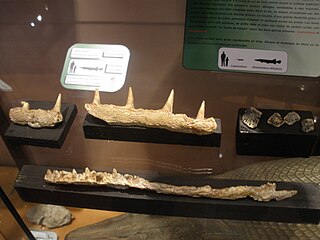
Atractosteus africanus is a potentially dubious species of gar from the Late Cretaceous of Niger and France.

Obaichthyidae is an extinct family of ginglymodian ray-finned fish that lived in what is now Africa, South America, and southern Europe during the Cretaceous period. They were close relatives of the modern gars of the family Lepisosteidae, with the two groups making up the superfamily Lepisosteoidea.

Atractosteus grandei is an extinct species of gar in the family Lepisosteidae. Remains have been found in Lower Paleogene sediments from North Dakota. A. grandei belonged to the genus Atractosteus which includes modern day species of gars such as the giant alligator gar and the tropical gar. It is named after paleontologist and ichthyologist Lance Grande.

Cuneatus is an extinct genus of gar that inhabited western North America during the early Paleogene. As the genus name suggests, they are distinguishable from modern gar by their cuneate (wedge-shaped) heads, with a significantly shortened snout. Three species are known: C. cuneatus, C. maximus, and C. wileyi.
Oniichthys is an extinct genus of gar in the family Lepisosteidae. It contains a single species, O. falipoui, known from the Late Cretaceous (Cenomanian) of Morocco.
Herreraichthys is an extinct genus of gar from the Late Cretaceous of Mexico. It contains a single species, H. coahuilaensis. The genus name honors the famous Mexican scientist Alfonso L. Herrera.

Grandemarinus is an extinct genus of gar from the Late Cretaceous of Morocco. It contains a single species, G. gherisensis. The genus name honors evolutionary biologist Lance Grande and references the species' apparent marine nature, while the specific epithet references Oued Gheris, a wadi near the type locality.

The Akrabou Formation is a Late Cretaceous -aged geological formation and Konservat-Lagerstätte in Morocco. It overlies the slightly older freshwater deposits of the Kem Kem Group, which it was once thought to be apart of. It was deposited over following the Kem Kem ecosystem's submergence by the Tethys Ocean during a marine transgression from the Cenomanian-Turonian boundary event, as part of a wider deposition of carbonate platforms across the region from the event.

Obaichthys is an extinct genus of lepisosteiform fish that inhabited South America, Africa, and southern Europe during the mid-Cretaceous period. It closely resembled modern gars, which it was related to, but differed in its spiny scales and restricted mouth gape. The genus name references the Yoruba spirit Ọba, who is worshiped in the Candomblé religion in Brazil.
